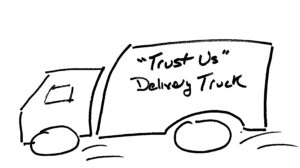An easy way to think about trusts is to consider the example of a delivery truck. A delivery truck driver has no control over how a package is addressed by the sender. The truck driver has no control (other than his delivery schedule) over who receives the package. The driver transports the package as directed. This is a very simple way of considering what a trust is and how it works. When you create a trust, its a bit like packaging something up for delivery. 
Your trustee has possession of the trust assets (the law calls this legal title, but you might think of it as being on the truck), but can only use those assets consistent with your instructions; this is a lot like giving the driver specific delivery instructions. You can select different delivery speeds, which is similar to deciding how long a trust will last or when it does its job. You can make trust (or delivery) simple, or you can make it complicated. In other words, this isn’t something beyond your understanding. You just need to decide what you want your delivery driver to do and then tell your lawyer to draft the trust documents (aka delivery instructions).
Trustees often have discretion concerning how and whether to take specific action. This is similar to express discretion such as permissive delivery instructions, or implicit discretion which is similar to a delivery driver selecting which road to use when delivering the package.
Trusts can have specialized purposes as can specialized delivery services. For example, a trust might protect public benefits eligibility for someone with special needs, just as refrigerated trucks might keep food fresh through the delivery process, or tankers might carry liquids. Trusts can be flexible, just as some delivery services haul shipping containers which can easily be switched out.
Other ways to extend this example include describing how a trustee might become liable to a beneficiary or another person. Trustee negligence might occur if a trustee makes an unreasonable investment or fails to maint
ain trust property, causing the trust assets to lose value. This is similar to making a claim against a delivery service for breaking or losing a package. Also, a trustee can be liable for breaching his or her fiduciary duty by stealing trust property or using it for the wrong person. This would be analogous to a delivery driver stealing a package or delivering it to the wrong person.
The key takeaway here is that you should understand what you have if you use a trust, or if you have one prepared for your loved ones. You should understand the reason for (or purpose of) the trust, and how to operate it to achieve that purpose.





